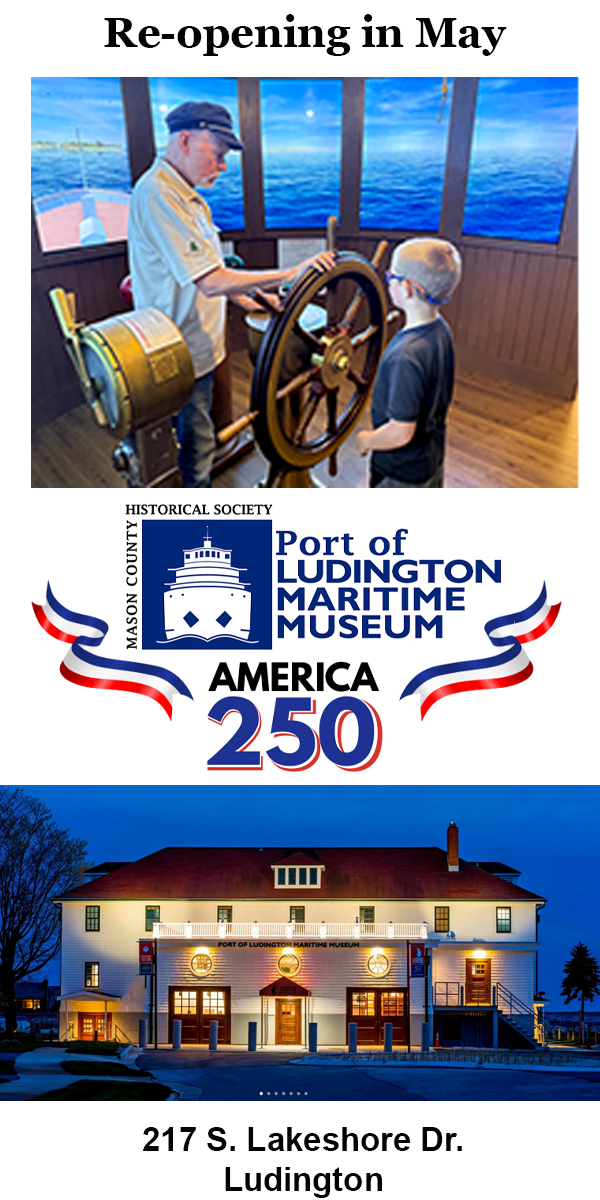
Charles Comley
History: Murder on the shores of Crystal Lake
By Rob Alway, Editor-in-Chief
A bizarre murder took place along the shores of Crystal Lake on Saturday, Jan. 20, 1934. The victim was 62-year-old Bertha Bean, also known as Bertha Comley. The sole suspect was Bean’s common law husband, 68-year-old Charles Comley, a former Chicago Board of Trade operator who had been living along the Amber Township lake for the past 10 years.
The initial newspaper report, published on Monday, Jan. 22, 1934 in the Ludington Daily News, stated that Bean was found in the cellar of Comley’s cottage. It described the body has being battered and bleeding, clad only in pajama pants and a bath robe.
A newspaper article reported that Comley told officers his wife had apparently fallen down the cellar stairs while he was outside working in the yard. He had heard her scream, he said, and went into the house to find her lying in the tiny cellar at the foot of the stairs. According to his version, she told him she was going to die and asked him to notify her son Charles in Chicago. “After futile attempts to lift her, he asserted, he went for aid,” the article read.
Editor’s Note: An interesting observation about journalism of that era, nowhere in the initial Jan. 22 Daily News articles about the murder is the victim’s full name mentioned. Her name, as Mrs. Comley, isn’t even mentioned until the third paragraph. For the remainder of this article, the victim will be referred to by her legal surname, Bean, and the suspect will be referred by his surname, Comley.
Comley owned the property that is now the Crystal Lake Campground along modern Hansen Road (most roads were not named in Mason County until after 1947). Several articles refer to him as a “resort owner” so it’s likely that he started the campground. Comley built his cottage on Crystal Lake in 1923, as stated by a neighbor during testimony.
Comley told investigators that he left the scene and went over to the Claus Chilberg residence so he could use a telephone. Comley then said that Claus and his boys were out in the field so he sought the help of his neighbor, John Borgh, a former secret service officer who had retired to Crystal Lake.
However, according to Carol (Chilberg) Fitch, that isn’t exactly accurate. Carol’s parents, Claus and Louise (Omholt) Chilberg, lived on 40 acres of land on the southeast corner of what is now Amber and Hansen roads; the modern address is 1529 W. Hansen Road and the house still exists. She said her dad wasn’t around but her 15-year-old brother, Karl, was. Carol was born the next month, in February. Carol said her mother would talk about the murder.
“My parents used to play cards with them,” Carol said. “Karl was asked to go over and try to help bring the woman back up the stairs. He could have picked her up easily but she was in very bad shape and had been dropped and picked up several times.”

Plat book from late 1920s shows the Comley property.
Carol said Karl was called to testify. “My dad was so upset with (Comley) that he would not go talk to him in the jail. He was so mad that he had jeopardized Karl, who was just a young boy, and jeopardized the baby, who was me.”
The Chilberg family owned several acres of farmland on the southeastern side of Crystal Lake. Nels and Hilda (Soneral) Chilberg were married on Dec. 20, 1887 in Ludington and moved to their Amber Township farm in 1904, according to Hilda’s obituary. Nels died on Dec. 27, 1937 and Hilda died on July 20, 1953. They had three sons, Roy, George, and Claus and one daughter, Nellie Stowe. The Chilberg farm bordered the lake along what is now Chilberg Road and along Amber Road, Hansen Road and Gordon Road. Much of the original orchards and farm land still exists.
John Borgh owned property directly west of Comley’s property. A sidebar article interviewing him appeared in the Jan. 22, 1934 edition of the Ludington Daily News. In the article, Borgh talked about the friendship of he and his wife and the Comleys. An immigrant of Sweden, Borgh said he shared a bond with Comley, who was an immigrant from England. Borgh said he had known Comley since Comley built his cottage there in 1923. Borgh had lived there since 1918.
“Mrs. Comley was a lovely woman and the four of us, Mrs. Borgh and myself and the two of them were close mutual friends,” Borgh is quoted saying. “She, Mrs. Comley, first came here about six years ago as a resorter. She came back the following year and I believe had maintained her home here most of the time since then.
“The last time we saw her alive was Friday morning about 11:30, the day before her death. Dressed in knickers she came over and seemed like she had something she wanted especially to say, but there was another neighbor present so she didn’t say much.”

Sheriff Colyer
Bean was first examined by Dr. C.M. Spencer of Scottville. Spencer was initially called to the Comley cottage and testified that she had been dead for over an hour when he had arrived. Spencer testified that the body was lying at the bottom of the cellar stairs, leading down from a trap door, in the kitchen of the Comley home. The body lay with the head toward the stairs, he said, and the legs and lower part of the body were bent around the lower step. The face was badly bruised and bloated, the skin was off over both cheek bones with bad bruises on the forehead and under the chin. Blood had apparently oozed from the left ear and mouth and down the left side of the face.
Spencer also stated that there were abrasions on the skin of both wrists and countless bruise marks over the entire front surface of the body. “These same bruise marks were generally scattered over the legs and thighs, particularly below the knees and the skin was rubbed off one ankle,” a newspaper account stated.
Spencer testified that he called coroner Rubert Stephens of Stephens Funeral Home in Scottville, along with Dr. F. W. Heysett of Ludington and Dr. Ivan L. Hunt of Scottville, to assist in the post mortem examination, which took place at the funeral home. He said that all confirmed evidence of three brain hemorrhages and a fracture of the skull behind the left ear.
“They determined the death was due to the hemorrhages,” a news article stated.
In the initial news article reporting on the article, it was stated that “Authorities concurred in the belief the innumerable cruises and contusions found on the body were not likely to have been caused by a tumble down the six-foot flight of stairs.”
Spencer, along with several other witnesses, also talked about fresh scratches that were apparent on Conley’s face.
“Comley stoutly maintained the marks had been caused when he fell into a brush heap Friday afternoon,” a news article stated.
 Conducting the initial criminal investigation, besides the medical officials, were Sheriff George Colyer, deputy Ed Anderson and Mason County Prosecuting Attorney Jack Ellasohn. Sheriff Colyer served as sheriff from 1918-1923 then again from 1926 to 1941, the longest serving sheriff in Mason County history. Ed Anderson served as sheriff from 1941-1964.
Conducting the initial criminal investigation, besides the medical officials, were Sheriff George Colyer, deputy Ed Anderson and Mason County Prosecuting Attorney Jack Ellasohn. Sheriff Colyer served as sheriff from 1918-1923 then again from 1926 to 1941, the longest serving sheriff in Mason County history. Ed Anderson served as sheriff from 1941-1964.
Comley was arraigned on a single count of first degree murder and was scheduled to appear for a jury trial in Circuit Court in March. However, on March 6, 1934, Comley was brought from the Mason County Jail to Paulina Stearns Hospital in Ludington where he underwent an operation “for the removal of a growth.” Sheriff George Colyer reported to the newspapers that Comley’s condition was not serious.
The sheriff stated that Comley had been ill for some weeks since his confinement. It’s likely that Comley had cancer, which is what ultimately killed him.
Bertha Bean is often referred to as Mrs. Comley in newspaper reports. Though in today’s society, it is generally accepted that unmarried couples live together, in the 1930s, it was considered taboo. Newspaper articles revealed that most people didn’t know that Comley and Bean were not legally married, including some of their closest friends.
Bertha Bean was born as Bertha Pierce in 1872 in Aurora, Ill. On July 31, 1900, she married Fred Nelson Bean (1872-1959) and they had three children, Charles (1902-1978), Pierce (1906-1981) and Harry (1911-1991). There isn’t an online record of their divorce. A newspaper article, following the death, stated that Bean’s brother, A.W. Pierce, and her three adult sons, came up from Chicago to help return her body to Illinois.
Charles Edward Uriah Comley was born on May 3, 1865 in Worcester, Cornwall, England, the son of William Comley and Sarah Batchelor (no relation to the Batchelors who settled near Round Lake). Both his parents died in 1865 in England, leaving behind nine children. In 1868, probate records show that Charles and his eight siblings, were sent to live with their uncle, Thomas Comley, in Cornwall, England. From a family tree, it appears that Charles and his siblings may have moved from household to household. He eventually immigrated with his brothers to Chicago in 1885 at the age of 20.
On April 22, 1889 Comley married Maud E. Howard in Des Moines, Iowa. His occupation is listed as a grain broker in Wichita, Kansas. On the marriage certificate he claims he was born in Worcester, N.Y., while it’s really Worcester, England. The two were divorced sometime before 1910. Maud died on Jan. 14, 1920 in Chicago at the age of 50.
In 1900, Comley reported to the Census Bureau that he was a trade broker in Chicago where he lived with Maud and their 11-year-old daughter Lucile Bevan Conley. Lucile died in 1932 at the age of 42, 11 days after having her gall bladder and appendix removed at the Battle Creek Sanatorium, which was operated by Dr. John Harvey Kellogg inventor of Kellogg’s Cereal.
In 1910, Comley is listed as working in real estate and living in Washburn, Wis.
On Dec. 7, 1918, he is listed as marrying Zina Undine Areaux, 28, in Three Rivers, Michigan. He is 53. The two were divorced on Nov. 22, 1920. Two days later, Zina married another man, Willard Merle Paxson in Cassopolis, Michigan.
In Jan. 1926, at the age of 50, he was living in Scottville and fills out a marriage certificate with Dorothy Schuler, 38. However, according to records found at the Mason County Clerk’s Office, the license was never filed, meaning they were never legally married.
Comley had told law enforcement that he had lived with four women since he had moved to Crystal Lake, stating that two of them were his legal wives.
The newspapers of the early 20th century served as social media of the time. As communications, such as the telephone and rural mail carrier service, improved, the social activities of people were often reported in daily and weekly newspapers. Mr. and Mrs. Charles Comley’s name appeared frequently in the pages of the Ludington Daily News in the early 1930s, receiving guests at their Crystal Lake home and visiting friends in other places. In addition, Comley was a regular contributor to the Daily News, providing a weekly report from Crystal Lake which typically focused on fishing and other wildlife.
Crystal Lake is also referred to as Hackert Lake. The name Hackert honors the legacy of Charles and Sarah Hackert who came to Amber Township in 1861 in a covered wagon with four other families, according to a 1954 Ludington Daily News article. Charles Sr. and Sarah stayed at Peters Lumber camp at Crystal Lake until they located their farms in southern Amber Township. The Hackerts continues to farm land in Amber Township including in area adjacent to the lake. The name Hackert wasn’t used until about 1940. In 1948, the U.S. Board of Geographic Names published a decision declaring the name officially as Hackert Lake, though many people have continued to call it Crystal Lake for the last eight decades.
The trial of Charles Comley began on Tuesday, April 10, 1934. Mason County Prosecuting Attorney Jack Ellasohn, and assistant prosecutor Howard L. Campbell called 24 witnesses.
Defending Comley was Scottville attorney Walter Glenn (W.G.) Alway (great-grandfather of the author) and J. Lindsay of the law firm Linsay, Shively and Phelps of Grand Rapids. Alway worked as an attorney in Scottville from 1914 to his death in 1955. He served several years as Scottville’s justice of the peace.
The 12-member jury included C. Hackett, A. Benson, Albert Beebe, John Burns, Edward Ruhsert, Harold Richardsoth, Clifford Marble, Russell Ditlow, John Kaiser, Peter Carlson, Herbert Wright and C. Coleman.
During the trial, witnesses talked about the abusive relationship between the couple. Witnesses said Bean had stated several times that she wanted to commit suicide because of Comley’s abuse. Among those testifying were the Borghs, and Olga Chadwick.
“He insisted in butting into the cooking,” Mrs. Chadwick said during testimony, “and Mrs. Comley didn’t like that. They always seemed to be bickering about it. If he made coffee, it didn’t suit her; if she made coffee, it didn’t suit him. That’s the way it went; she didn’t like his butting in.”
Mr. Borgh testified that on numerous occasions Comley told him that he would like to “get rid of her,” referring to Bean.
On Thursday, April 12, 1934, following a three-day trial and four hours of deliberations, a jury reached a verdict of guilty of manslaughter. He was sentenced the next day by Circuit Court Judge Hal L. Cutler to serve 7.5 to 15 years in prison, with a recommendation that he serve a minimum of 10 years.
“The sentence was pronounced at 4:20 p.m. in a courtroom crowded with spectators who had come to hear the wind-up of the case which, opening Tuesday, had attracted wide interest in the state since that time,” a newspaper article recounted.”
Comley was sent to prison in Jackson. On July 21, 1935, Comley died in the Michigan State Prison Hospital following an operation to treat bladder cancer, likely the same issue he had when he underwent a procedure at Paulina Stearns Hospital in March 1934.
Comley did not have any direct heirs, as his daughter died two years before the murder.
Please consider helping to fund local news. Mason County Press and Oceana County Press are available for free thanks to the generous support of our advertisers and individuals. Three ways to help us: Venmo: @MasonCountyPress; Paypal: MasonCountyPress@gmail.com; Mail a check to PO BOX 21, Scottville, MI 49454.
This story is copyrighted © 2023, all rights reserved by Media Group 31, LLC, PO Box 21, Scottville, MI 49454. No portion of this story or images may be reproduced in any way, including print or broadcast, without expressed written consent.
As the services of Media Group 31, LLC are news services, the information posted within the sites are archivable for public record and historical posterity. For this reason it is the policy and practice of this company to not delete postings. It is the editor’s discretion to update or edit a story when/if new information becomes available. This may be done by editing the posted story or posting a new “follow-up” story. Media Group 31, LLC or any of its agents have the right to make any changes to this policy. Refer to Use Policy for more information.















































.png)



